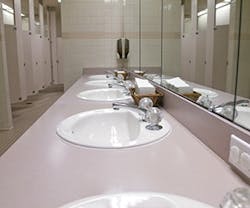First impressions count, as any business professional or service provider will tell you. That doesn’t just apply to personal interaction – it’s true for your washrooms too.
Planning a renovation? Make sure your facilities make the grade by paying attention to these four A’s.
1) Aesthetics
A more welcoming residential feel is becoming increasingly popular in washroom renovations, especially in facilities designed for a wide variety of ages and ability levels such as a retail development, says Jason Renner, senior product manager for the commercial plumbing group at Bradley Corporation, a manufacturer of commercial plumbing fixtures and washroom accessories.
“Now you’ll see warmer tones in the tile and some of the lighting,” Renner observes. “The partitions are sometimes tied to the handwashing fixtures from a color scheme standpoint vs. the restrooms of yesteryear that had white or blue tile and looked more institutional and sterile.”
Restrooms focusing mainly on one type of audience, such as a school where preschool or kindergarten areas have their own dedicated washrooms, can have a design targeted closer to their narrow demographic, says Johnny Comoara, owner of Philadelphia-based Johnny C Construction, a firm specializing in commercial and residential building and remodeling.
“For little kids, you have to have a friendly environment with a warm color,” Comoara explains. “You could go with light pinks, greens, and blues, and some manufacturers make special lines of paints for kids.”
2) ADA Accommodation
Safety and accessibility are top considerations for any restroom. Knowing your audience well helps you go above and beyond the minimum required by ADA, Renner notes.
That may mean a set number of wheelchair-accessible stalls in your office building, a handful of sinks or toilets lower to the ground in your school, or a series of guard rails in your healthcare facility or senior center.
“Make sure products are easily reachable and accessible by all. In some commercial applications with multiple sinks or basins, you can mount one at a lower height, not just for children, but for people of short stature,” Renner explains. “Or you might only be looking at it from an ADA perspective, with products that meet the requirements but don’t push it any further.”
Facilities serving children would do well to read up on ADA’s child-specific regulations, which account for minors’ unique needs, dimensions, and anthropometrics.
However, if your washroom is regularly visited by both smaller children and adults – for example, in a hospitality setting – consider maximizing the space with multi-height products, Renner adds.
“If the product is designed properly, it should be accessible by children, the elderly, or your average able-bodied individual,” Renner says.
3) Abuse
Unfortunately, abuse is an ever-present consideration for any restroom with heavy traffic. A high-abuse environment requires vandal-resistant materials that have been load-tested, suggests Renner.
Stainless steel is a great material for support structures and mounting brackets of fixtures due to its strength, he adds, but it can scratch or dent if subjected directly to abusive behavior.
“Use other materials that are easily repaired and cleaned, are impact resistant, and have some color options,” Renner recommends. “Solid surface material like Terreon is very easy to clean with everyday cleaners – any graffiti or cigarette burns can be scrubbed out with a Scotch-Brite pad. You’ll also see it used in countertops, partitions, and shelving. There are also some natural quartz and fiberglass materials on the market.”
4) Access and Convenience
Besides making your washroom a sturdy yet welcoming place to be, the end result of your renovation should also emphasize convenience.
“One common thing today is hands-free technology,” Renner says. “People don’t want to touch anything in commercial washrooms if they don’t have to, so make sure they have hands-free faucets, soap dispensers, and hand dryers.”
Make sure walkways are wide enough to eliminate crowding and allow visitors to enter and leave quickly. The convenience factor combined with an aesthetically pleasing, easy-to-use environment results in a better experience. Depending on your environment, this could result in more sales or happier students.
“Facilities that have nicer, cleaner restrooms are more likely to have repeat business or customers,” Renner says. “Restrooms should be viewed as an extension of a building. The convenience, access of products, and hands-free technology tie together today’s public restroom, regardless of user type.”
Janelle Penny [email protected] is associate editor of BUILDINGS.
About the Author
Janelle Penny
Editor-in-Chief at BUILDINGS
Janelle Penny has been with BUILDINGS since 2010. She is a two-time FOLIO: Eddie award winner who aims to deliver practical, actionable content for building owners and facilities professionals.

